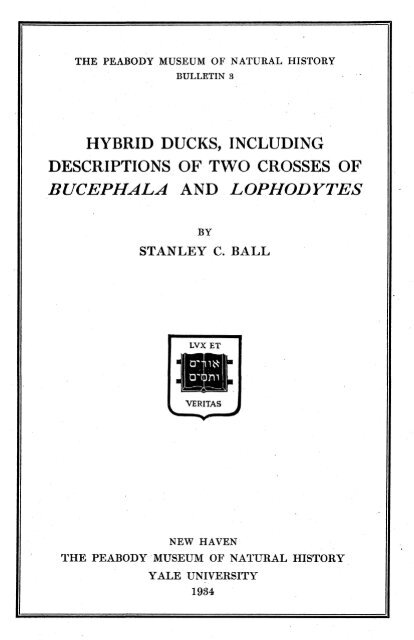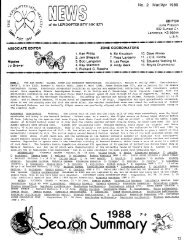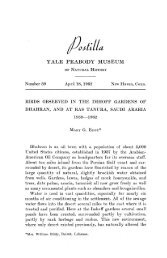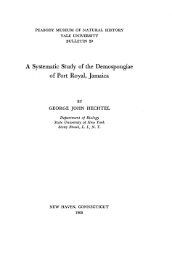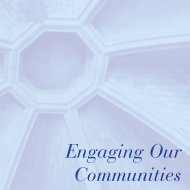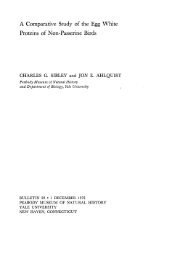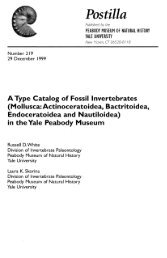Bulletin 3 - Peabody Museum of Natural History - Yale University
Bulletin 3 - Peabody Museum of Natural History - Yale University
Bulletin 3 - Peabody Museum of Natural History - Yale University
Create successful ePaper yourself
Turn your PDF publications into a flip-book with our unique Google optimized e-Paper software.
PEABODY MUSEUM OF NATURAL HISTORYTRUSTEESJAMES ROWLAND ANGELL, PH.D., LITT.D., LL.D.HIS EXCELLENCY THE GOVERNOR OF CONNECTICUT, ex-<strong>of</strong>ficio.REV. WILLIAM ADAMS BROWN, PH.D., D.D.HOWELL CHENEY, M.A,VANCE CRISWELL MCCORMICK, M.A.FRED TOWSLEY MURPHY, M.D., M.A.SAMUEL HERBERT FISHER, LL.D.DIRECTORRICHARD SWANN LULL, PH.D., SC.D.CURATORSEDWARD SALISBURY DANA, PH.D., Curator <strong>of</strong> Mineralogy, Emeritus.GEORGE GRANT MAC CURDY, PH.D., Curator <strong>of</strong> Anthropology, Emeritus.CHARLES SCHUCHERT, LL.D., Sc.D., Curator <strong>of</strong> Invertebrate Paleontology,Emeritus.STANLEY CRITTENDEN BALL, PH.D., Curator <strong>of</strong> Zoology.CARL OWEN DUNBAR, PH.D., Curator <strong>of</strong> Invertebrate Paleontology.WILLIAM EBENEZER FORD, PH.D., Curator <strong>of</strong> Mineralogy.RICHARD SWANN LULL, PH.D., SC.D., Honorary Curator <strong>of</strong> VertebratePaleontology.CORNELIUS BERRIEN OSGOOD, PH.D., Curator <strong>of</strong> Anthropology.ALBERT EIDE PARR, M.A., Curator <strong>of</strong> the Bingham OceanographicCollection, and Scientific Director <strong>of</strong> the <strong>Yale</strong> OceanographicExpeditions.EDWARD SAPIR, PH.D., SC.D., Honorary Curator <strong>of</strong> Anthropology.MALCOLM RUTHERFORD THORPE, PH.D., Curator <strong>of</strong> Vertebrate Paleontology.RESEARCH ASSOCIATESGEORGE GRANT MACCURDY, PH.D., Research Associate in PrehistoricArcheology, Emeritus.HELLMUT DE TERRA, PH.D., Research Associate in Geology.MALCOLM RUTHERFORD THORPE, PH.D., Research Associate in VertebratePaleontology.CHARLES EDWIN WEAVER, PH.D., Research Associate in InvertebratePaleontology.RESEARCH ASSISTANTSJAMES BROOKS KNIGHT, PH.D., Research Assistant in InvertebratePaleontology.CLARA MAE LEVENE, B.A.NELDA EMELYN WRIGHT, M.A.ADVISOR IN GEOLOGYCHESTER RAY LONGWELL, PH.D.DOCENTSMILDRED CYNTHIA BEULAH PORTER, M.A., in charge.DOROTHY EMMA ARNOLD, B.A.GERTRUDE HOTCHKISS CLARK.
THE PEABODY MUSEUM OF NATURAL HISTORYBULLETIN 3HYBRID DUCKS, INCLUDINGDESCRIPTIONS OF TWO CROSSES OFBUCEPHALA AND LOPHODYTESBYSTANLEY C. BALLLVX ETNEW HAVENTHE PEABODY MUSEUM OF NATURAL HISTORYYALE UNIVERSITY1934
HYBRID DUCKS, INCLUDINGDESCRIPTIONS OF TWO CROSSES OFBUCEPHALA AND LOPHODYTESBy STANLEY C. BALI,MANY hybrid clucks have been recorded, but as pointed outby Bigelow (1907, p. 382), few specimens have been fullydescribed. Suchetet in 1896 published a summary <strong>of</strong> all descriptions<strong>of</strong> hybrid birds then in print.Since Bigelow's 1907 paper numerous additional instances havebeen recorded. Reviewing the literature, we find crosses betweenmany species. A suggestive list <strong>of</strong> these follows, the nomenclaturebeing that <strong>of</strong> Peters' Check-list (1931).Anas platyrhynchos (Mallard) X Anas rubripes (Black duck) .... 3" " " X Anas fulvigula fulvigula (Floridaduck) .... 1X Anas acuta (Pintail) 4X Mareca americana (Baldpate) ..X Spatula clypeata (Shoveller) ...X Netta rufina (Red-crested duck)X Anas superciliosa (Gray duck) . .X Anas crecca (Teal)X Mareca penelope (Widgeon) ....X Chaulelasmus streperus (Gadwall)X Cairina moschata (Muscovy) . . .X Somateria molissima borealis(Northern eider)X Nyroca ferina (Pochard)X Mergus merganser (Goosander)Anas obscura (Dusky) X Anas undulata (<strong>of</strong> South Africa)......Anas acuta (Pintail) X Anas crecca (Teal)" " " X Spatula clypeata (Shoveller)X Anas querquedula (Garganey)Branta leucopsis (Barnacle goose) X Anser fabalis (Bean goose)Cairina moschata (Muscovy) X Tadorna tadorna (Shield-drake). .X Alopochen aegyptiaca (Egyptian"goose")24311116
4 PEABODY MUSEUM OF NATURAL HISTORYCairina moschata (Muscovy) X Anser anser (Gray-lag) 1" " " X Spatula clypeata (Shoveller).... 1Aix sponsa (Wood duck) X 10 other speciesDendronessa galericulata (Mandarin) X 2 other speciesMareca penelope (Widgeon) X 6 other species (7 cases)Anas crecca (Teal) X 3 other speciesNyroca ferina (Pochard) X Aix sponsa (Wood duck) 1" ' " " X N. africana (White-eyed duck) 1X N. fuligula (Tufted duck) 1" " " X Anas rubripes (Black duck) 1X othersNyroca marila (Greater scaup) X N. africana (White-eyed duck) 1Nyroca fuligula (Tufted duck) X 3 other speciesNyroca collaris (Ring-neck) X N. americana (Redhead) . ^ . 1Melanitta fusca (Velvet scoter) X M. perspicillata (Surf scoter) 1Bucephala clangula clangula (Golden-eye) X Mergellus albellus(Smew) 51. Mergus anatarius Eimbeck, $ , 1825, "Oker River, nearB runs ink/"2. Clangula angustirostris Brehm, $, 1829, Germany.3. Clangula mergoides Kjarboling, #, immature. In collectionpurchased in Copenhaven, 1853.4. February 1865, near Pol.5. Nov. 20, 1881, at Kalmarsund. Skin at <strong>University</strong> <strong>of</strong>Upsala in 1896.B. clangula clangula $ X Mergus merganser $ 1Seen mating at Negelin, Oldenbourg. The male was shot.B. clangula clangula X Nyroca ferina (Pochard) 1B. " " X N. marila (Greater scaup) 2B. " " X Melanitta fusca (Velvet scoter) 1Bucephala clangula americana (American golden-eye) X Lophodytescucullatus (Hooded merganser) 21. Clangula mergiformis Cabot, $ , Maine, 1854.2. New Haven, $ , 1920. Described in this paper.At least 63 species (more than 94 instances) have mated withspecies not their own. Anas platyrhynchos leads (14 species and30 matings) ; others worthy <strong>of</strong> note are Nyroca ferina (8 and20) ; Aix sponsa (10 and 10) ; Cairina moschata (4 and 10).
HYBRIDS OF THE GOLDEN-EYE (Bucephalaclangulaclangula) AND THE SMEW (Mergellus albellws)OF special interest in connection with this paper are thehybrids <strong>of</strong> the European golden-eye (B. clangula clangula)and the smew (Mergellus albellus) listed above, two <strong>of</strong> which maynow be considered in some detail.Number 1. This hybrid is described by Eimbeck (in Suchetet)as like the male Bucephala c. clangula in size, and in form <strong>of</strong> bodyand tail; more like Mergellus in its long nape plumes, beak andpointed wings.From its extremity to the corner <strong>of</strong> the gape the beak is 46.5mm.; base higher than wide; distal part flat, wider than high.Seen from the side it resembles beak <strong>of</strong> merganser, but the serrationsare less visible. The statement that the form is especiallystriking when seen from above may imply that the beak is narrowand parallel-sided as in the merganser.In color and pattern this bird stands intermediate between thetwo parent species. Foundation white; head and neck deepiridescent green; white spot between beak and eye; back brilliantblack, with some scapulars white; breast feathers mostly borderedwith black, having as marks traces <strong>of</strong> the two black collar-bandsso conspicuous in Mergellus, large wing feathers pure white (fromwhich statement we may infer that at least a part <strong>of</strong> the covertsare black) ; feet not quite so large as in Bucephala but <strong>of</strong> sameform; deep rusty, web nearly black. Brilliant, well-coloredplumage stamps this bird as a male in prime plumage.Number S. Kjarboling (in Suchetet) first regarded this as ayoung $ M. albellus, but later saw its relationship to Bucephala.In general color he found it similar to Eimbeck's male describedabove, but juvenile feathers were particularly evident on the head.The hybrid Anas platyrhynchos X Mergus merganser is interestingfor comparison with those previously described. Accordingto Schliiter's description (1891) it shows strongly the characters<strong>of</strong> a domestic mallard drake, thus implying that it is a
6 PEABODY MUSEUM OF NATURAL HISTORYmale. In size, however, it approaches the larger Mergus merganser^on which account Schliiter assumed this species ratherthan M. serrator to have been the mother.In form the beak resembles that <strong>of</strong> A. platyrhynchos, but issomewhat larger and wider. The nail, a somewhat interruptedzone on the upper surface, and the base as well, are horn-colored;the rest yellowish brown. Head and adjacent neck feathers gray.A few cheek feathers end in a faint greenish gloss as in thedomestic drake, while some neck feathers show a rusty red coloron their edges, inherited from the red-headed merganser. Throatyellowish-white although not so extensively as in the femaleMergus. Lower neck shows wide band <strong>of</strong> white, broken on hindneck by dark gray feathers like those <strong>of</strong> head. The breast has,although weakly indicated, the brown feathers <strong>of</strong> the mallard,shot through with gray, and grades into color <strong>of</strong> belly whosefeathers have grayish-white bases and borders, speckled as inA. platyrhynchos. Lower tail coverts similar, partly bordereddistally with black.Back and upper tail coverts show mixture <strong>of</strong> spotted bellyfeathers from the A. platyrhynchos $, and blue-gray backfeathers <strong>of</strong> M. merganser 9 . Upper tail coverts also have blackterminal borders. Middle tail coverts blue-gray; the outer onesshorter with white outer edges. Wholly wanting is the tendency<strong>of</strong> the central coverts to curl upward as in the male mallard.Primaries as well as under wing coverts are white; the speculumblue-gray. Blue-green upper wing coverts edged with reddishbrown.Feet stronger than mallard's, but similar.
HYBRIDS OF THE MERGANSER (LophodytesAND THE GOLDEN-EYE (Bucephala clangulacucullatus)americana)(PI. I, Fig. 2; PI. Ill, Fig. 17)ON December 20, 1920, while duck hunting near the breakwaterat the mouth <strong>of</strong> New Haven harbor, Mr. L. Genungshot a handsome hybrid duck which is now in the collections <strong>of</strong>the <strong>Peabody</strong> <strong>Museum</strong> <strong>of</strong> <strong>Natural</strong> <strong>History</strong> at <strong>Yale</strong> (Cat. No.4745). The shallowness <strong>of</strong> bill and number <strong>of</strong> tail feathers (18)at once suggest merganser affinities, while the width and lamellation<strong>of</strong> bill and color pattern point to one <strong>of</strong> the ducks as theother parent.On account <strong>of</strong> the small number <strong>of</strong> North American Merginaeit is expedient to determine first to which <strong>of</strong> these this bird isrelated. The key to this part <strong>of</strong> the riddle is the two pairs <strong>of</strong>black bands which extend from the back half way down the sides<strong>of</strong> the breast. Only the hooded merganser (Lophodytes cucullatus)has these. Further comparison brings out the followingpositive characters resembling this species: size small; sides <strong>of</strong>breast and flanks tinged with cinnamon; small amount <strong>of</strong> whiteon the scapulars; tertials black, four <strong>of</strong> them each with a narrowwhite central stripe; shape <strong>of</strong> crest; black <strong>of</strong> upper neck joinedto that <strong>of</strong> the back by a broad dorsal stripe along the back <strong>of</strong>the neck.The American merganser (Mergus americanus) could havecontributed neither the breast bands nor the vermiculations onthe sides and flanks. Furthermore, it has a complete ring <strong>of</strong>white about the lower neck (true also <strong>of</strong> Bucephala), a light grayrump and tail, and a longer bill whose sides are orange-red.This merganser lacks a crest and is relatively a larger bird(635-685 mm.).That the red-breasted merganser (M. serrator) is not concernedin this hybrid is concluded from the following considerations.The hybrid lacks the black-flecked reddish breast, andthe row <strong>of</strong> peculiar black-bordered white feathers on the side <strong>of</strong>
8 PEABODY MUSEUM OF NATURAL HISTORYthe upper breast in front <strong>of</strong> the wing; its posterior scapularshave much less white, and the bill lacks the orange, and the backand tail the gray color which characterize M. serrator; no evidence<strong>of</strong> the elongated two-pointed crest exists; the black on theneck all round extends farther posteriorly on the hybrid, and theblack band along the back <strong>of</strong> neck is broader. Again, the redbreastedmerganser is a larger bird (508-635 mm.).Both positive and negative evidence, then, point to Lophodytescucullatus as one <strong>of</strong> the parents. As to the other parent, therecan be no doubt that it was either the American golden-eye(Bucephala clangula americana) or Barrow's golden-eye (B.islandica) ; all other ducks are excluded by their size or colorpattern, or both.Two characters <strong>of</strong> the hybrid favor B. clangula americana.First, the iridescence <strong>of</strong> the head and neck is distinctly greenrather than purple and violet. Secondly, the single black wingbar across the bases <strong>of</strong> the greater coverts is so narrow as tosuggest that, with L. cucullatus having two distinct bars acrossthe white wing patch, the other parent must have had less <strong>of</strong> abar than does B. islandica; B. c. americana has none. The differencesbetween the bills <strong>of</strong> the two species <strong>of</strong> Bucephala are notsufficiently great to be helpful in determining which had crossedwith such a long, shallow-billed bird as a merganser.Having settled upon Lophodytes cucullatus and Bucephalaclangula americana as the parents <strong>of</strong> this hybrid, one sees that itstands as an extraordinary intermediate between the two species.
HYBRID DUCKSTABLE ICOMPARISON OF NEW HAVEN HYBRID WITH ADULT MALES OFLOPHODYTES AND BUCEPHALAFORM OF MALELophodytes cucullatus Hybrid No. 4745Length,Wing(folded),191-201Tail, length, 80-105" number <strong>of</strong>feathers, 18Bill*Culmen, loralline to tip, 40-42 mm.Height fromfrontal angle tolower edge <strong>of</strong>upper mandible, ;,9.5Least height (10mm. from tip),Width at base,Width (10 mm.from tip),439-502mm.4.512.57.9Width <strong>of</strong> scale, 6.1From each edge <strong>of</strong> uppermandible project a-bout 24 lamellae or serrations,<strong>of</strong> which the mostposterior point somewhatbackward, their outerfaces slanting obliquelyinward and forward. Onthe more anterior teethsuccessively, these outerfaces slant inward lessand less until in the terminalteeth they paralleledge <strong>of</strong> mandible. (Figs.7, 10.)445 mm. (as mounted)2131031843 mm.14.5Heighttip, 61712.76.910 mm. fromAbout 32 small serrationsalong each edge <strong>of</strong>upper mandible are almostconcealed from lateralview. As in L. cucullatus,the more posteriorteeth extend obliquely inwardand forward, whilethe anterior lie nearlyparallel with the edge.These teeth are the ends<strong>of</strong> lamellae which curveobliquely upward and forwardon inner surface <strong>of</strong>bill. (Figs. 8, 11.)Bucephala clangulaamericana535-586 mm.230-23890-1191641-45 mm.22.5-24.5Least height (10 mm. fromtip), 7.5-9.519-2218-196-6.5About 33 lamellae extendfrom each edge <strong>of</strong>upper mandible directlyupward on inner surface<strong>of</strong> bill. Tips <strong>of</strong> a fewposterior lamellae arebarely visible below edge<strong>of</strong> mandible in the driedskin. (Figs. 9, 12.)* It may be noted from the measurements above that the beak <strong>of</strong> Lophodytestapers considerably in width, while that <strong>of</strong> Bucephala has nearly parallel sides.The New Haven hybrid favors the merganser in this character, while the BostonSociety bird approaches the golden-eye.
10 PEABODY MUSEUM OF NATURAL HISTORYLophodytescucullatusHybrid No. 4745Bucephala clangulaamericanaLower mandible hasalong its upper edgescorresponding serrationswhich slant inward andbackward. The anteriormost<strong>of</strong> these unite t<strong>of</strong>orm a continuous knifelikeedge. (Fig. 7.) Noseries <strong>of</strong> ridges extendingon outer aspect <strong>of</strong>lower mandible.Both upper and lowerteeth remain visible whendried bill is closed.Tarsus,29-31 mm.Middle toe andnail, 52Number <strong>of</strong> scaleson top <strong>of</strong> outertoe, 44-46Scales in the row alongfront <strong>of</strong> tarsus (overlying3rd metatarsal) allsimilar; central ones notdistinctly wider thanthose below. (Fig. 13.)Has distinct crest, laterallycompressed; longestnape feathers, 48 mm.Lower mandible has oneach upper edge 40 smallserrations, or lamellae, <strong>of</strong>which the anterior extendbackward and inw&rd, andthe posterior directly inward.Anterior teeth notunited as in L. cucullatus.A series <strong>of</strong> 46 short externallamellae along thesuperior-lateral face <strong>of</strong>the lower mandible, eachtooth extending obliquelydownward and backward,as in Bucephala. (Figs.8, 11.)Closure <strong>of</strong> bill hides allthese teeth and lamellae.316144-47Scalation <strong>of</strong> left legas in L. cucullatus; <strong>of</strong>right leg as in Bucephala.(Figs. 14, 15.)Crest fairly developed;longest nape feathers,33 mm.On each upper edge <strong>of</strong>lower mandible is a series<strong>of</strong> 51 serrations or lamellae,<strong>of</strong> which the posteriorextend directly inwardand the anteriorobliquely backward andinward.A series <strong>of</strong> 46 welldeveloped lamellae alongeach side <strong>of</strong> bill as inmost ducks; each ridgeextends obliquely downwardand backward.(Figs. 9, 12.)Closure <strong>of</strong> bill hides allthese ridges.38-416854-56Middle scales in therow on front <strong>of</strong> tarsusdistinctly wider than theones below, thus reducingabruptly the width <strong>of</strong>the outer row <strong>of</strong> scales(overlying 3rd metatarsal).(Fig. 16.)No distinct crest; longestnape feathers, 23 mm.Head, entire neck,black. Broad white patchextends from back <strong>of</strong> eyeCOLOR OF MALEEntire head (includingcrest) and neck black,not extending so far pos-Head and upper neckblack, with strong greeniridescence; large round-
HYBRID DUCKS 11Lophodytescucullatusupward and backwardcovering most <strong>of</strong> thecrest; edge <strong>of</strong> latterblack. Sides <strong>of</strong> head andneck with faint greenishiridescence.Back seal brown.The black <strong>of</strong> neck joinsbrown <strong>of</strong> back broadly.Breast and belly white.Two black crescenticbars extend from upperback before wing downsides <strong>of</strong> white breast.Fore wing, i.e., middleand lesser coverts, gray.In folded wing, whitepatch on outer edges <strong>of</strong>secondaries and greaterwing coverts is crossedby a distinct bar <strong>of</strong> black5 mm. wide (the blackbases <strong>of</strong> secondaries notbeing covered by greatercoverts).A second black bar(exposed bases <strong>of</strong> greatercoverts) divides the whitewing patch from gray <strong>of</strong>fore wing (middle andlesser coverts).Hybrid No. 4745teriorly on ventral surfaceas in L. cucullatus.Sides <strong>of</strong> head and neckwith moderate greenishiridescence.Back dark seal brown,washed with black.The black <strong>of</strong> neck joinsblack <strong>of</strong> back broadly.Breast and belly white.Two black bars extendfrom upper back downsides <strong>of</strong> breast; bars narrowerand shorter thanin L. cucullatus.Fore wing dark mousegray,some feathers onleft wing fading to whiteat tips.White wing patch moreextensive than in L. cucullatus,covering theouter secondaries, greaterand middle coverts andmuch <strong>of</strong> the lesser coverts(to within 22 mm.<strong>of</strong> front edge <strong>of</strong> wing).Black on bases <strong>of</strong> secondariesso much coveredby white ends <strong>of</strong> greatercoverts, that no distinctbar in this position isevident.Anterior black wingbar present as in L.cucullatus.Bucephala clangulaamericanaed white spot betweengape <strong>of</strong> bill and eye.Back black.Lower neck white allaround, continuous withwhite <strong>of</strong> underparts.Breast, belly, crissumand under tail covertswhite.No black bars on sides<strong>of</strong> breast.Front edge and bend<strong>of</strong> wings black (30 mm.wide).In folded wing thewhite patch is very largeand lacks the black crossbar because bases <strong>of</strong>greater secondaries areless extensively blackand hence covered bywhite ends <strong>of</strong> greatercoverts.No black bar on greatercoverts; their blackbases are covered bywhite middle coverts.
12 PEABODY MUSEUM OF NATURAL HISTORYLophodytes cucullatus Hybrid No. 4745Inner vanes <strong>of</strong> secondariesand all <strong>of</strong> tertialsblack, the outer 5 tertialswith a narrow medianstripe <strong>of</strong> white (about3 mm. wide).Scapulars black.Primaries seal brown.Tail seal brown.Sides and flanks reddishbrown, cross-wavedand barred with black,finely in front, coarselybehind.Sides <strong>of</strong> belly drabbrownslightly barredwith whitish. Belly posteriorlywith brownishtips.Under tail coverts drabbrown,speckled andbarred with white.Bill black.Iris yellow.Legs and feet lightyellowish brown.Six outer secondarieswhite over entire outervane; in some the innervanes are partly white.Inner secondaries and allthe tertials black; 4 outertertials each with narrowwhite median stripeas in L. cucullatus,Scapulars black, theouter ones with broadwhite central stripe asin B. clangula americana*Primariesto black.seal brownTail seal brown washedwith ash.Bucephala clangulaamericanaEight outer secondariesentirely white.Inner secondaries entirelyblack. Tertialsdark brown.Outer scapulars whitewith black edges.Inner scapulars black.Primaries seal brown.Tail sealmuch ash.brownwithSides and flanks pale Sides <strong>of</strong> breast andcinereous vermiculated flanks white, the upperwith black, finely in front, flank feathers sharplycoarsely behind. Some edged with black.flank feathers washedwith cinnamon.Sides <strong>of</strong> belly darkbrown, the ends <strong>of</strong> somefeathers edged with whitish.A dusky bar separateswhite <strong>of</strong> belly fromwhite crissum.Under tail covertswhitish, distally washedand barred with drabbrown.Bill black.Iris golden yellow(glass eye).Legs and toes apparentlyyellow; webs darkbrown.Sides <strong>of</strong> belly drabbrown;tips washed withwhite. Crissum white.Underwhite.Bill black.tailIris golden yellow.covertsLegs and feet orangeor yellowish with duskywebs.
HYBRID DUCKS 13Reference to the tabular descriptions and to the illustrationsshows that the hybrid strikes nearly an average (blending)between the parents in the following nine characters:Length <strong>of</strong> wingLength <strong>of</strong> tailSize and shape <strong>of</strong> billSerrations or lamellae <strong>of</strong> billLength <strong>of</strong> crest feathersSize <strong>of</strong> feetExtent <strong>of</strong> white on outer secondariesDegree <strong>of</strong> green iridescence on head and neckColor <strong>of</strong> fore-wing.In eleven other characters the hybrid presents a mosaic, resemblingL. cucullatus in:Total lengthNumber <strong>of</strong> tail feathersLength <strong>of</strong> tarsusNumber <strong>of</strong> scales on top <strong>of</strong> outer toeShape <strong>of</strong> crestExtent <strong>of</strong> black on neckBlack stripe on back <strong>of</strong> neckPresence <strong>of</strong> black breast barsBlack wing bar on bases <strong>of</strong> greater covertsNarrow white stripes on inner secondaries and tertialsSides and flanks vermiculated with black and washed withcinnamon.Characters <strong>of</strong> the hybrid which approximate those in B.clangida americana are:Solid black color <strong>of</strong> head and neckExtent <strong>of</strong> white on wing coverts and outer secondariesBroad white stripes on outer scapularsWash <strong>of</strong> ash on tail.Perhaps as remarkable as any character in its distribution isthe scalation <strong>of</strong> the legs. On the left tarsus the shape andarrangement <strong>of</strong> scales in the anterior rows closely follows that<strong>of</strong> the merganser, while the right reproduces that <strong>of</strong> the goldeneye(Figs. 13-16).
14 PEABODY MUSEUM OF NATURAL HISTORYIn these tabulations <strong>of</strong> the characters <strong>of</strong> the hybrid drawn fromits mismated parents it is to be noted that no cephalic white spotsenter. Both the loral patch <strong>of</strong> Bucephala and the white crestarea <strong>of</strong> Lophodytes have been suppressed. This fact might beused as an argument in favor <strong>of</strong> assuming as the merganser parentMergus americarms, which lacks white on the head and has ahigher degree <strong>of</strong> greenish iridescence than does Lophodytes. Butthese considerations are outweighed by others already emphasized.Many interspecific and intergeneric crosses are known amongducks, but this specimen seems to be the second recorded hybridbetween members <strong>of</strong> the North American subfamilies <strong>of</strong> theAnatidae. Certainly the mergansers and golden-eyes are moreunlike physically than are the mallard {Anas platyrhynchos)and the baldpate (Mareca americana) <strong>of</strong> which a hybrid isdescribed by Elliot (1892, p. 165).Propinquity during the breeding season would be more probablein the western parts <strong>of</strong> the continent, although not impossiblein the east. Bent (1923, p. 13) gives the breeding range <strong>of</strong>Bucephala clangula americana as follows:Mainly north <strong>of</strong> the United States, entirely across the continent.South to Newfoundland (Humber and Sandy Rivers), northern NewBrunswick (Northumberland County), central Maine (Washington toOxford Counties), New Hampshire (Umbagog Lake and Jeffersonregion), northern Vermont (St. Johnsbury), northern New York(Adirondacks), northern Michigan (Neebish Island, Sault Ste. Marie),northern Minnesota (Lake County), northern North Dakota (DevilsLake), northwestern Montana (Flathead Lake and Glacier NationalPark), and the interior <strong>of</strong> British Columbia.North to the limits <strong>of</strong> heavy timber in central Alaska, southernMackenzie, the southwest coast <strong>of</strong> Hudson Bay, and the northeastcoast <strong>of</strong> Labrador. Replaced in northern Europe and Asia by aclosely allied race.The breeding range <strong>of</strong> Lophodytes cucullatus, according toForbush (1925, p. 188), is:Locally in wooded regions from southeastern Alaska, central BritishColumbia, Great Slave Lake, northern Manitoba, Ontario and New
PLATE IFig. 1. Hooded merganser (Lophodytes cucullatus).Fig. 2. Hybrid (L. cucullatus x Bucephala clangula americana), Cat. No.4745, <strong>Peabody</strong> <strong>Museum</strong>.Fig. 3. American golden-eye (Bucephala clangula americana).Figs. 4, 5 and 6 are dorsal views <strong>of</strong> the beaks <strong>of</strong> these respective birds.Figs. 1-3, X %• Figs. 4-6, X 1.PLATE IIFigs. 7, 8 and 9, beaks <strong>of</strong> L. cucullatus, the hybrid, and B. c. americana.Fig. 10. Enlargement <strong>of</strong> the part <strong>of</strong> beak between lines x-y in Fig. 7.a, lamellae on left-hand edge <strong>of</strong> upper mandible; a, inner surfaces <strong>of</strong> lamellaeon right-hand edge; b, lamellae <strong>of</strong> lower mandible.Fig. 11. Similar enlargement <strong>of</strong> part <strong>of</strong> Fig. 8.lamellae.Fig. 12. Same for Fig. 9. Note the great lateral lamellae, c.Note c, the short lateralFigs. 13 and 14. External views <strong>of</strong> left tarsi <strong>of</strong> L. cucullatus and hybrid,showing similar arrangement <strong>of</strong> scales in the two large anterior rows.Fig. 15. External view <strong>of</strong> right leg <strong>of</strong> hybrid, showing second row <strong>of</strong> scalesinterrupted by wide central scale, a, <strong>of</strong> first row.Fig. 16. Normal scalation <strong>of</strong> B. c. americana, left leg, with the samearrangement as in Fig. 15.Figs. 7-9, x %Fi S s - 12 ~ 16 > X 1-PLATE IIIFig. 17. Hybrid (L. cucullatus x Bucephala clangula americana). InBoston Society <strong>of</strong> <strong>Natural</strong> <strong>History</strong>; Cat. No. 17972. X Vz-Fig. 18.X 2 A-Beak <strong>of</strong> same, enlarged to show the serrations and lamellae.Fig. 19. Hybrid (Anas platyrhynchos x Anas rubripes). In <strong>Peabody</strong><strong>Museum</strong>, <strong>Yale</strong> <strong>University</strong>; Cat. No. 11035. X T A-a. Right side, showing white wing bars.b. Left side, showing general pattern.
PLATE I'#»"# *
PLATE 11a a b c10*r*~•J!-.: t*.;,*f%V-yr•V**•A**.,% :% P\11# ;*• **' .&ffV .*•. •4116*2*'••*."* -^.*' *»'&.~Wi• *?>**$>
PLATE IIIMA
HYBRID DUCKS 15Brunswick (probably in central Ungava (northern Quebec), southernLabrador and Newfoundland) south to Oregon, northwestern Nevada,northern New Mexico, southern Louisiana, southern Tennessee, Alabamaand central Florida.The overlapping winter ranges <strong>of</strong> the two species concernedwould have permitted the mating <strong>of</strong> this hybrid's parents beforetheir northward migration, for Bent (1925, p. 13) sets the winterrange <strong>of</strong> the golden-eye thus:Cold coasts and large lakes south <strong>of</strong> frozen areas. On the Atlanticcoast commonly from Maine to South Carolina; more rarely north tothe Gulf <strong>of</strong> St. Lawrence and Newfoundland and south to northernFlorida. Rarely to the Gulf coasts <strong>of</strong> Mississippi, Louisiana, andTexas. On the Pacific coast from the Commander and AleutianIslands to southern California and casually to central western Mexico(Mazatlan). On the Great Lakes (Michigan, Erie, and Ontario).Irregularly north in the interior to southern British Columbia, northwesternMontana, and the valleys <strong>of</strong> the Missouri and MississippiRivers, as far as Nebraska and Iowa; and south to Colorado andArkansas and occasionally to Arizona and Texas.This region is overlapped by the winter range <strong>of</strong>given by Forbush (1925, p. 188) as:Lophodytes,Southern British Columbia, Utah, Colorado, Nebraska, Illinois,Indiana, Pennsylvania and Massachusetts south to Lower California,southern Mexico, the Gulf states and Cuba; uncommon to rare innortheastern part <strong>of</strong> range. Recorded from St. Michael, Alaska, alsoIreland, Wales and Bermuda.Since the hooded merganser is seldom seen on salt water, theliaison, if it were contracted south <strong>of</strong> the breeding grounds,probably took place on some <strong>of</strong> our inland streams or ponds.As to nesting habits, it is interesting to note that bothLophodytes and Bwcephala are tree dwellers. Therefore the siteselected by his mate was doubtless approved by the male, whetherhe were merganser or golden-eye.While it would be idle to speculate concerning the sex <strong>of</strong> thetwo species involved, since this male hybrid could as well haveinherited his characters from either male or female parent <strong>of</strong>
16 PEABODY MUSEUM OF NATURAL HISTORYeither species, one may be allowed to imagine that the male parentwas Bucephala, for it is well known that the male golden-eye,even among amorous ducks, is an especially ardent wooer(Brewster, 1911). One may also infer that this hybrid inheritedfrom its golden-eye parent at least a tolerance <strong>of</strong> salt water.A search <strong>of</strong> the literature has revealed but one other recordedhybrid between Lophodytes and Bucephala. This interestingexample was presented to the Boston Society <strong>of</strong> <strong>Natural</strong> <strong>History</strong>in May, 1854, by H. D. Morse, having been taken May 2 atScarborough, Maine, by Caleb Loring, Jr. Dr. Samuel Cabotexhibited this bird (Cat. No. 17972) at the following June meeting<strong>of</strong> the Society. His description, published in the Proceedings<strong>of</strong> 1854-56, includes notes on both external and internal anatomy.Cabot's specimen is a male, apparently two years old, cominginto adult nuptial plumage.A description <strong>of</strong> the successive Lophodytes plumages may befound in A. C. Bent's "Life Histories <strong>of</strong> North American WildFowl" (1923, pp. 26,27):The downy young is thickly and warmly clothed with s<strong>of</strong>t down indeep, rich shades <strong>of</strong> "bister" or "sepia" above, including the upperhalf <strong>of</strong> the head, the hind neck, and the flanks; the sides <strong>of</strong> the head,neck, and cheeks, up to the eyes, are "buff pink" or "light vinaceouscinnamon," the chin, throat, and under parts are pure white; andthere is an obscure dusky band across the chest and an indistinctwhite spot on each side <strong>of</strong> the scapular region and rump.In the first plumage the sexes are alike and much resemble the adultfemale, but they are browner on the back and have undeveloped crests.Young males wear this immature plumage all through the first year,with only a slight change toward maturity during the first spring andthe following summer. The summer molt leaves them still in immatureplumage and with but little change in the new wings, which stilllack the pearl-gray lesser coverts and in which the greater covertsare only slightly white-tipped. In November and December <strong>of</strong> this,their second winter, they begin to assume a plumage resembling that<strong>of</strong> the adult; the molt begins with the appearance <strong>of</strong> black feathersand white feathers in the head, spreading downward to the breast,flanks, and scapulars, until by March or April a nearly adult plumage
HYBRID DUCKS 17is assumed. In this plumage the colors are all duller than in oldmales; the crown, back, and rump are browner; the gray lesser wingcovertsare acquired, but the wings are otherwise immature. A partialeclipse plumage is assumed during the next summer, when the birdis two years old and late in the fall, November or December, the fullyadult plumage is acquired. Young females can be distinguished fromadults during the first year by their undeveloped crests and theirduller and browner coloring everywhere; they become indistinguishablefrom the adults during the second winter.Adult males have a semi-eclipse plumage in summer, in which thehead arid neck become largely mottled with brownish and the breastand flanks lose their brilliant colors and resemble those <strong>of</strong> the female.The double molt is probably not complete, though the whole plumageis changed at least once. The full plumage is assumed early in thefall, much earlier than in young birds, and is usually complete inOctober.We may now return to Cabot's hybrid. Taken in the secondspring, the feathers <strong>of</strong> its neck, head, and well-developed crestare still largely in the immature brown stage, although manyblack feathers have already appeared. These are especiallyconspicuous on the neck, which is dark gray to the base as inLophodytes. Other immature characters are the sprinkling <strong>of</strong>black tips on the white feathers <strong>of</strong> the basal ventral surface <strong>of</strong>the neck and anterior breast, and the ashy edges <strong>of</strong> the dorsalbody feathers, intensified by wear.This hybrid lacks the white stripes on inner secondaries andtertials which are peculiar to the adult male Lophodytes, andalso lacks the white outer margins <strong>of</strong> the scapulars present inBucephala. Perhaps in time they would have developed. Thesame possibility exists with regard to the very rudimentary blackbands extending ventrally in front <strong>of</strong> the wing on the sides <strong>of</strong> thebreast, the white wing patch, the tertial and scapular stripes.Doubtless maturity would have sharpened the contrast betweendark neck and white breast feathers. As in the adult malehooded merganser, but less intensively and over a smaller area,the sides <strong>of</strong> the breast and flanks are washed with cinnamon andvermiculated with black.
18 PEABODY MUSEUM OF NATURAL HISTORYThe outer secondary alone is bordered with white, but this issufficiently prominent to form as in Lophodytes the posteriorwhite bar, separated by the black basal bar across this secondaryfrom the anterior white wing bar across the ends <strong>of</strong> the greatercoverts. The middle and lesser coverts are white, irregularlymottled and washed with gray.The beak resembles that <strong>of</strong> the merganser more closely thanthat <strong>of</strong> the golden-eye, thereby approaching the New Havenhybrid in character, but unlike the latter, its beak, instead <strong>of</strong>tapering, is parallel-sided as in clangula (Fig. 6). The serrationsand lateral lamellae, especially on the lower mandible, areless well developed than in the New Haven bird, although closelysimilar in form and arrangement. Both hybrids follow Lophodytesin the shape and position <strong>of</strong> the nostrils.Whereas the New Haven specimen in scalation <strong>of</strong> its tarsifollows Lophodytes on one leg, and Bucephala on the other, theMaine hybrid resembles the latter on both tarsi.Compare with Table I, the following:TABLEANALYSIS OF IMMATURE MALE HYBRID, LOPHODYTES CUCUL-LATUS X BUCEPHALA CLANGULA AMERICANA (BOSTONSOCIETY OF NATURAL HISTORY, CAT. NO. 17972)A. EXTERNAL ANATOMY (FIGS. 17, 18)Length450 mm.Wing . 222Tail, length 110Number <strong>of</strong> rectrices 18BillCulmen, loral line to tip 41.5Height, from lower edge <strong>of</strong> upper mandible t<strong>of</strong>rontal angle 17Least height (10 mm. from tip) . . . 6Width <strong>of</strong> base 16" 10 mm. from tip 13" <strong>of</strong> scale 8II
HYBRID DUCKS 19About 26 serrations along each edge <strong>of</strong> upper mandible are almostconcealed from lateral view. They agree with those in the NewHaven hybrid in form and direction.On each upper edge <strong>of</strong> the lower mandible are 45 serrations similarin form and arrangement to those in the New Haven hybrid, but thesix anteriormost hardly rise above the surface.A series <strong>of</strong> 39 short external lamellae occurs along the superiorlateralface <strong>of</strong> lower mandible as in the New Haven hybrid. Closure<strong>of</strong> bill hides all teeth and lamellae.The upper mandible is almost parallel-sided, thus resemblingBucephala more closely than does the New Haven hybrid.Tarsus34 mm.Middle toe and nail 62Number <strong>of</strong> scales on top <strong>of</strong> outer toe 44Scalation <strong>of</strong> both legs as in Bucephala (Fig. 16).Crest well developed; longest feathers 38 mm.B. COLORSecond spring plumage, still immature; considerably worn.Head and neck chestnut brown, with many newly formed blackfeathers. Dark color does not descend downward so far on fore-neckas in Lophodytes; meets white <strong>of</strong> breast in zone <strong>of</strong> immature spottedfeathers.Back dark seal brown; feathers edged with grayish.Dark color <strong>of</strong> neck and back broadly joined together.Breast and belly white; two black bars on sides <strong>of</strong> breast slightlydeveloped.Middle and lesser wing coverts white mottled with gray.White Wing-patch broken by two broad black bars across bases <strong>of</strong>secondaries and greater coverts. Outermost secondary alone has whiteband on outer vane.Scapulars black; primaries seal brown; tail seal brown; sides andflanks pale cinereous vermiculated with black as in the New Havenhybrid; sides <strong>of</strong> belly and crissum dark drab brown; bill black; glasseye golden yellow; legs and toes apparently yellow; webs darker.Apparently the genes which are responsible for many visiblecharacters <strong>of</strong> L. cucullatus and B. clangula americana segregated
20 PEABODY MUSEUM OF NATURAL HISTORYin true Mendelian fashion in the maturation <strong>of</strong> the gametes whichunited to produce the New Haven hybrid. Many <strong>of</strong> these geneswere able to exert almost their full influence, resulting in a birdwhich presents a remarkable mosaic <strong>of</strong> the two sets <strong>of</strong> parentalcharacters; for example, number <strong>of</strong> tail feathers, tarsal scalation,marking <strong>of</strong> tertials and scapulars. On the other hand,certain attributes appear as blends between homologous parentalstructures, e.g., size <strong>of</strong> bird, color <strong>of</strong> head, form <strong>of</strong> bill. Otherfeatures which are present in one parent and absent in the other,such as the two black breast bars, crest, lateral lamellae on beak,and vermiculations on flanks and sides, exist in the hybrid, buthave been modified somewhat in size, in form, or in both.While the same remarks apply to the hybrid from Maine, thecharacters are less well-defined owing to its immaturity.A comparative analysis <strong>of</strong> the two hybrids is given inTable III:Some characters which at first glance suggest that blendinghas occurred, upon analysis reveal the probability that they arein reality to be regarded as mosaics. For example, the head isentirely black in the New Haven hybrid, but incorporates theblack cheeks <strong>of</strong> Lophodytes and the black nape <strong>of</strong> Bucephala.From another point <strong>of</strong> view, neither the white cheek patches <strong>of</strong>the one nor the white crest patch <strong>of</strong> the other parent species wereable to develop. This may have been on account <strong>of</strong> a conflict<strong>of</strong> genes.When considering these matters, one should bear in mind theevident immaturity <strong>of</strong> the Maine hybrid, and the remote possibilitythat even the New Haven bird might in a following seasonhave developed more fully the pattern elements <strong>of</strong> one or bothparent species.Table III may be summarized as follows:No. <strong>of</strong> characters No. <strong>of</strong> blended No. <strong>of</strong> charactersfavoring characters favoringLophodytesBucephalaNew Haven Hybrid... 6% 3 - 7%Maine Hybrid 6% 3 5
Like LophodytesNew Haven ..BlendingNew Haven ..Like BucephalaNew Haven ..Like LophodytesNew Haven ..BlendingNew Haven ..Like BucephalaNew Haven ..1 • 1Size<strong>of</strong>bodyXX10WhiteonscapularsX2 IGeneralform andsize <strong>of</strong>beakXX11Whitestripesontertials* Probably on account <strong>of</strong> immaturity.X3 1Laterallamellaeon lowermandibleXX12Blackbar ongreatercovertsXXTABLE III4 1Serrationson edge<strong>of</strong> uppermandibleCloseSimilar13Lesser andmiddle covertsmoreor less grayXX5 1TwoblackbreastbarsV 2 lengthRudimentary*14Extension<strong>of</strong> whitewingpatchXX6CrestpresentXX15Vermiculationson sidesand flanksXbut lessextensiveXbut lessextensiveiBnEirec
22 PEABODY MUSEUM OF NATURAL HISTORYThis summary reveals the consistency <strong>of</strong> inheritance in thetwo birds. Maturity might have brought out in the Mainehybrid one more character from Lophodytes (white tertialstripes), and two more characters <strong>of</strong> Bucephala (white scapularmarks, green iridescence on head).Of the 18 characters observed, 13 were similarly inherited byboth hybrids (1, 2, 3, 4, 5, 6, 7, 9, 12, 13, 15, 16, 18); 3 areuncertain because <strong>of</strong> immaturity <strong>of</strong> the Maine bird (8, 10, 11) ;one (17) follows Bucephala in the Maine hybrid, while in theNew Haven bird the character appears complete as in Lophodyteson one leg, and as in Bucephala on the other leg; finally, a singlecharacter (14), with due allowance for immaturity, is reversedin the two hybrids.One may now pr<strong>of</strong>itably compare with the Maine and NewHaven hybrids a few characters <strong>of</strong> Eimbeck's European hybridBucephala clangula clangula X Mergellus albellus described onan earlier page. This bird was a fine male in full plumage.One parent {Bucephala) was almost identical for all three birds.The other parent {Lophodytes) was identical for both Americanhybrids, but for the European was another species <strong>of</strong> black andwhite merganser, the smew. This species {Mergellus albellus)differs considerably from Lophodytes, especially in lack <strong>of</strong> crest,but resembles it in possessing two black crescentic bands on eachside <strong>of</strong> the white breast, and two white wing bars.Eimbeck's hybrid inherited traces <strong>of</strong> the black breast bars <strong>of</strong>Mergellus, the black head and green iridescence <strong>of</strong> Bucephala(wing bars not mentioned). Absence <strong>of</strong> crest is consistent withits absence in both parents.The striking feature, as contrasted with the two Americanspecimens, is the presence <strong>of</strong> a "white spot between the beak andeye.'* In this respect the Bucephala pattern dominated.Both Guyer (1909) and Phillips (1914) remark on the preponderance<strong>of</strong> males among hybrid ducks, especially in caseswhere the parents are distantly related. It is interesting to notethat all hybrids discussed in this paper are males.
HYBRID MALLARD (Anas platyrhynchos)DUCK (Anas rubripes)X BLACK(PI. Ill, Fig. 19)THIS bird (<strong>Peabody</strong> <strong>Museum</strong>, <strong>Yale</strong> <strong>University</strong>, Cat. No.11035) was taken with two wild red-legged black ducks atMilford, Connecticut, November 11, 1932. It resembles A.rubripes rubripes closely on head and neck. The upper andunder parts <strong>of</strong> the body are somewhat lighter and warmer incolor. Feathers <strong>of</strong> the breast and under tail coverts especiallyare widely margined with vinaceous-cinnamon (IV/15). Many <strong>of</strong>them have one or more additional interrupted bars <strong>of</strong> the samecolor. This reddish tendency is doubtless inherited from themallard.Even more mallard-like are the wings. Although in hue thespeculum is greenish-blue, as in the black duck, it is bordered bythe two white bars <strong>of</strong> the mallard, one crossing the greatercoverts below their black tips and the other whitening the ends <strong>of</strong>the secondaries. The white under wing coverts show theirrubripes inheritance in the broken row <strong>of</strong> dark spots near theedge <strong>of</strong> the wing. Like both mallard and black duck, this hybridhas white axillars, but is exceptional in bearing one right axillarwith three broad, but incomplete bars and a terminal spot <strong>of</strong> gray.When first seen the tarsi were lighter colored than in the blackduck, and less orange than in the mallard; according to Ridgway'snomenclature (1896) the hue was two-thirds salmon (PlateVII, No. 17) and one-third saturn red (VII, 16) ; feet somewhatmore dilute. Tarsi <strong>of</strong> a black duck taken at the same timewere two-thirds salmon and one-third orange vermilion (VII, 12).In form the only notable hybrid character is in the bill. Thisis intermediate between the higher, wider, parallel-sided beak <strong>of</strong>A. rubripes and that <strong>of</strong> A. platyrhynchos which is narrower atthe base and somewhat flatter anteriorly. When fresh the colorwas chromium green (X, 12) warmed with olive-yellow (VI, 16)
24 PEABODY MUSEUM OF NATURAL HISTORYtoward the base, and fading through sage green (X, 15) to peagreen (X, 9) at the tip; darker along antero-lateral edge; nailnearly black; upper surface <strong>of</strong> culmen dusky. The bill <strong>of</strong>A. rubripes taken at the same time was nearly ochre yellow(V, 9), with nail and margin darker; much darker on inside <strong>of</strong>upper mandible and on teeth <strong>of</strong> lower mandible.There can be no possibility that this bird is an immature malemallard, for the head and neck are typically ashy as in the blackduck, not buffy. The tail feathers lack the white margins <strong>of</strong> themallard and are in prime condition instead <strong>of</strong> being ragged andworn as is usually true <strong>of</strong> the immature mallard in November.The breast is very much darker than that <strong>of</strong> a young mallard.
BENT, A. C.BIBLIOGRAPHYLife histories <strong>of</strong> North American wild fowl.U. S. Nat. Mus. Bull. 126, 1923; Bull. 130, 1925.BlGELOW, H. B.On hybrids between the mallard (Anas boschas) and certain otherducks.Auk, vol. 24, pp. 382-388, 1907.BREWSTER, WILLIAMCourtship <strong>of</strong> the American golden-eye or whistler.The Condor, vol. 13, pp. 22-30, 1911.CABOT, SAMUELWild hybrid duck, Clangula americana and Mergus cucullatus.Abstract, Proc. Boston Soc. Nat. Hist., vol. 5, pp. 118-120,1854.ELLIOT, D. G.Hybridism, and a description <strong>of</strong> a hybrid between Anasand A. americana.Auk, vol. 9, pp. 160-166, 1892.boschasFORBUSH, E. H.Birds <strong>of</strong> Massachusetts and other New England States, vol. 1, p.188, 1925.GUYER, M. F.On the sex <strong>of</strong> hybrid birds.Biol. Bull., vol. 16, pp. 193-198, 1909.PETERS, J. L.Check-list <strong>of</strong> the birds <strong>of</strong> the world.Vol. 1, Harvard Univ. Press, 1931.PHILLIPS, J. C.Size inheritance in ducks.J. Exp. Zool., vol. 16, pp. 131-148, 1914.
26 PEABODY MUSEUM OF NATURAL HISTORYRIDGWAY, ROBERTNomenclature <strong>of</strong> colors for naturalists.Boston, 1896.ScHLUTER, W. VONHybrid Anas boscas X Mergus merganser.Ornitholog. Jahrbuch. Bd. 1, Heft 1, pp. 109-110, 1891.SlJCHETET, A.Des hybrides a l'etat sauvage. Classe des oiseaux.Regne animal, vol. I, pp. 1002, Paris, 1897.ZOOLOGICAL RECORD, 1900-1931.
Additional Copies<strong>of</strong> this <strong>Bulletin</strong> may be procured from<strong>Peabody</strong> <strong>Museum</strong> <strong>of</strong> <strong>Natural</strong> <strong>History</strong>, <strong>Yale</strong> <strong>University</strong>,New Haven, Conn.,at25 cents per copy.


